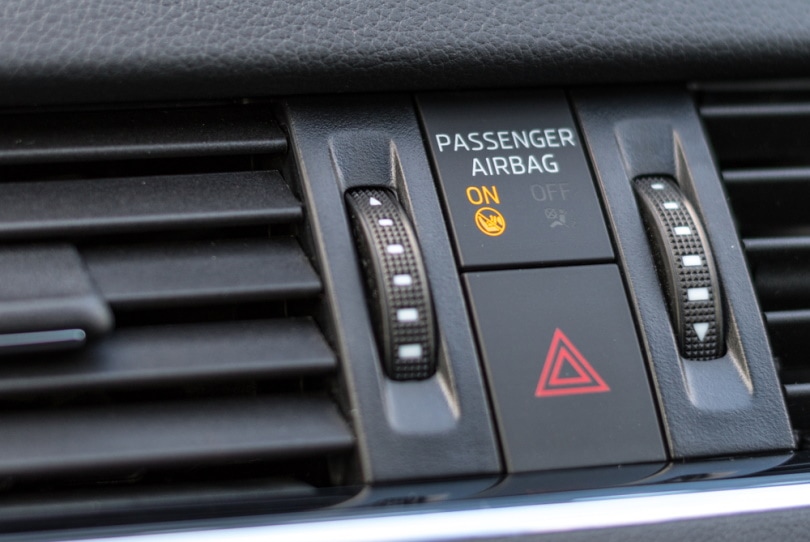How Much Force Does It Take to Deploy an Airbag: Facts & FAQ
-
Pete Ortiz
- Last updated:

Airbags are lifesavers and have saved over 50,000 lives¹ from 1987 to 2017. But how much force does it take to deploy an airbag? Contrary to popular belief, airbags are not deployed by a loud explosion or pyrotechnics.
In fact, the entire process is quite simple and happens in just a fraction of a second. If the driver and passenger have their seatbelts on, the car needs an impact of about 16 mph. Keep reading as we explain further.
Force Needed to Deploy an Airbag
The force needed to deploy an airbag depends on whether the driver and passenger have their seatbelts on or not. If they wear their seatbelts, the car needs an impact of between 10 and 12 mph to deploy airbags.

How Do Airbags Work?
Airbags are filled with a gas that is produced by a chemical reaction. This reaction happens when two chemicals—sodium azide and potassium nitrate—come together. When the airbag is deployed, this gas expands quickly and fills up the airbag.
The airbag then pushes against the driver or passenger, absorbing some of the impact from the crash. The airbag will then quickly deflate so the driver or passenger can see and get out of the car.
While airbags effectively save lives, it is essential to note that they’re not perfect. Airbags can cause injuries, such as burns, broken bones, and even death. That’s why it’s essential to always wear a seatbelt when driving or riding in a car.
Seat belts help keep you in the proper position for airbag deployment, and they also help reduce the amount of force your body experiences during a crash. While airbags are a great safety feature, seatbelts should always be your first line of defense.
Can Static Electricity Deploy Airbags?
Static electricity can’t deploy airbags. For airbags to deploy, there must be a physical impact on the car’s sensors. The sensors are located in the front of the car and detect when the car has been in a collision.
When the sensors detect an impact, they send a signal to the airbag control module. The airbag control module is what causes the airbags to deploy. So, even if you have static electricity on your body, it won’t affect the airbags.

Where Are Airbag Sensors Located?
Airbag sensors are located in the front of the car, usually near the bumper. They’re designed to detect when the car has been in a collision and send a signal to the airbag control module. It’s not uncommon for faulty sensors to deploy airbags without impact.
Do Airbags Expire?
Yes, airbags do expire. After about six years, the chemical reaction that allows airbags to inflate starts to break down. This means the airbags will deploy with less force, which may not be enough to protect you in a crash.
For this reason, it’s important to check the expiration date of your airbags and replace them if necessary. You can usually find the expiration date on a sticker inside the glove compartment or the doorjamb.
It’s also essential to keep up with regular maintenance on your car. This includes air filter changes, oil changes, and tire rotations. By doing so, you can help extend the life of your airbags.
Can I Disconnect My Airbags?
Yes, you can disconnect your airbags. However, we don’t recommend doing so. Airbags protect you in the event of a crash, and they could save your life.
If you choose to disconnect your airbags, you’ll need to have the work done by a certified mechanic. They must disconnect the airbag control module and remove the airbag fuses. Once they’ve done this, your airbags will no longer deploy, even in a crash.

Can Airbags Be Risky?
Despite their effectiveness, airbags can cause injuries. As mentioned earlier, airbags can cause injuries such as burns, broken bones, and even death. Seat belts help keep you in the proper position for airbag deployment, and they also help reduce the amount of force your body experiences during a crash.
In addition to wearing a seatbelt, you should avoid sitting too close to the steering wheel or dashboard. When airbags deploy, they inflate with a lot of force, and you don’t want to be in their way. Also, avoid placing heavy objects on your lap. If an airbag deploys while you have a heavy object on your lap, the object could fly into your face and cause serious injury.
 Airbags Can Save Your Life
Airbags Can Save Your Life
Airbags are complex contraptions that could potentially save your life. Ensure your car’s airbags are in good condition. You never know when you could get involved in a car crash; the airbags might just help you see another day. Don’t forget to change your airbags before they expire and wear your seatbelts.
Related Reads:
Featured Image Credit: Pixel-mixer, Pixabay
Contents


